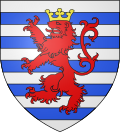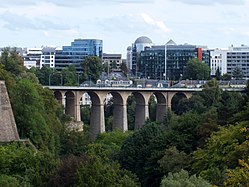Luxembourg City
The city of Luxembourg (Luxembourgish: [Lëtzebuerg] Error: {{Lang}}: text has italic markup (help), French: [Luxembourg] Error: {{Lang}}: text has italic markup (help), German: Luxemburg), also known as Luxembourg City (Luxembourgish: [Stad Lëtzebuerg] Error: {{Lang}}: text has italic markup (help), French: [Ville de Luxembourg] Error: {{Lang}}: text has italic markup (help), German: Stadt Luxemburg), is a commune with city status, and the capital of the Grand Duchy of Luxembourg.
|
Luxembourg / Lëtzebuerg / Luxemburg | |
|---|---|
 | |
Map showing, in orange, Luxembourg | |
| Coordinates: 49°36′36″N 6°07′40″E / 49.61000°N 6.12778°ECoordinates: 49°36′36″N 6°07′40″E / 49.61000°N 6.12778°E | |
| Country | Luxembourg |
| District | Luxembourg |
| Canton | Luxembourg |
| Commune | Luxembourg |
| Government | |
| • Mayor | Lydie Polfer (DP) |
| Area | |
| • Total | 51.7 km2 (20.0 sq mi) |
| Highest elevation | 408 m (1,339 ft) |
| Lowest elevation | 232 m (761 ft) |
| Population (2025)[1] | |
| • Total | 136,208 |
| • Density | 2,634.6/km2 (6,824/sq mi) |
| Time zone | UTC+1 (CET) |
| • Summer (DST) | UTC+2 (CEST) |
| LAU2 | LU00011001 |
| Website | Official website |
The city is at the confluence of the Alzette and Pétrusse rivers in southern Luxembourg. In the city is found the Luxembourg Castle, built by the Franks in the Early Middle Ages, around which a settlement developed.
History
During the Roman period, two main roads crossed the territory of the present city of Luxembourg; these two roads met at the place Marché-aux-Poissons (now a street and a neighborhood) dominated by a fortified tower. A castle was built here called Lucilinburhuc ("small castle"). In 963, this place became a property of Siegfried I, a close relative of the Emperors of Germany and Kings of France. Siegfried built a castle, not far from the "Lucilinburhuc" castle, on a rocky cliff called the Bock (Luxembourgish: [Bockfiels] Error: {{Lang}}: text has italic markup (help)). This place is now considered the birthplace of the city, the country and the nation.[2]
In 1994 UNESCO named the Old Quarters and Fortifications a World Heritage Site.[3]
Geography
The city of Luxembourg has an area of 51.73 km2 (20.0 sq mi), about 2% of the territory of the whole country. The altitude varies between 232 m (761 ft) high (Beggen, Bastogne street) and 408 m (1,339 ft) high (Dommeldange); it is 304 m (997 ft) high at the centre of the city.[4]
Luxembourg's climate is on the boundary of oceanic (Cfb in the Koeppen climate classification) and humid continental (Dfb) climates.
Population
As of 31 December 2024[update], there are 136,208 persons living in the commune,[1] for a population density of 2,633.1 inhabitants/km².
Twin cities
 Camden, United Kingdom, since 2007
Camden, United Kingdom, since 2007 Metz, France,
Metz, France, Tambov, Russia, since 2012
Tambov, Russia, since 2012 Prague, Czech Republic, since 2012
Prague, Czech Republic, since 2012
Luxembourg City Media
The Passerelle, also known as the viaduct or old bridge, overlooking the Pétrusse river valley. It opened in 1861.
View from the Grund up to the Old Town
Luxembourg City Hall is the heart of the communal administration, and hosts the offices of both the communal council and the mayor.
Casino Luxembourg is used for exhibitions of local art.
References
- ↑ 1.0 1.1 "La ville en chiffres". vdl.lu. Archived from the original on 14 January 2025. Retrieved 14 January 2025.
- ↑ "Histoire de la ville" (in French). Ville de Luxembourg. Archived from the original on 2 March 2013. Retrieved 5 May 2014.
{{cite web}}: CS1 maint: unrecognized language (link) - ↑ "City of Luxembourg: its Old Quarters and Fortifications". UNESCO. Retrieved 8 May 2017.
- ↑ "La ville en chiffres" (in French). Ville de Luxembourg. Archived from the original on 25 June 2014. Retrieved 5 May 2014.
{{cite web}}: CS1 maint: unrecognized language (link)
Other websites
| Wikimedia Commons has media related to Lua error in Module:Commons_link at line 62: attempt to index field 'wikibase' (a nil value).. |
- (in French) Ville de Luxembourg - Official website










